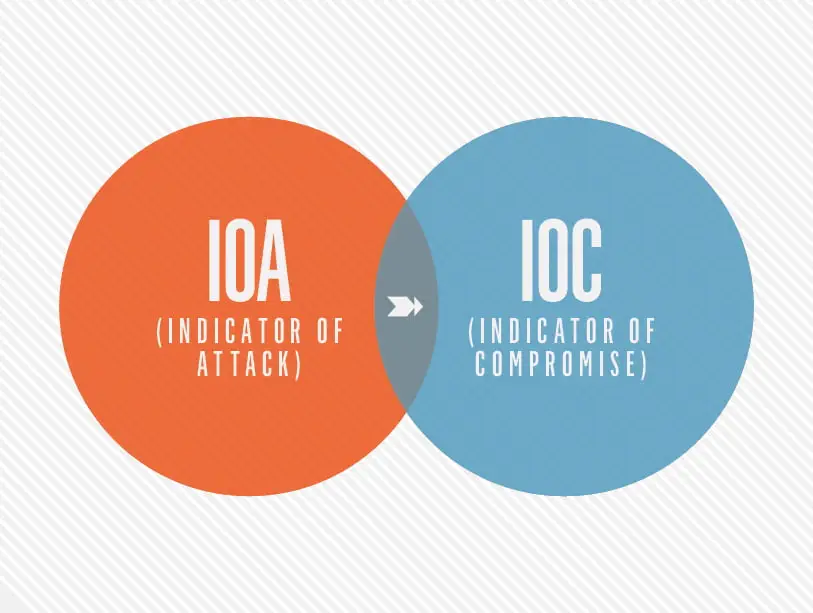Understanding the meaning and differences between IOC vs. IOA is crucial in cybersecurity.
While they may sound similar, they serve distinct purposes in identifying potential threats and fortifying cybersecurity defenses.
Let’s explore their definitions, their significance in identifying threats, and how they play different roles in strengthening cybersecurity measures.
What are Indicators of Compromise (IOC) Meaning in Cybersecurity?
Indicators of Compromise (IOC) form the forensic evidence that suggests a system has been breached or compromised. They act as telltale artifacts, scattered across various sources such as log files, network traffic, and system memory.
Examples of IOCs include IP addresses, domain names, file hashes, and patterns of behavior.
These nuggets of evidence allow security researchers and professionals to detect known malicious activities like malware infections, phishing attempts, and ransomware attacks.
IOCs are instrumental in uncovering common attack methods, such as brute-force attacks and SQL injections.
Through collaboration and information sharing within the cybersecurity community, security teams can detect and mitigate threats more effectively.

What is Indicators of Attack (IOA) Meaning in Cybersecurity?
Indicators of Attack (IOA) reveal the intentions and techniques employed by threat actors during a cyberattack.
Unlike IOCs that focus on specific artifacts, IOAs are concerned with patterns of behavior and the tactics, techniques, and procedures (TTPs) employed by attackers to gain unauthorized access to systems.
IOAs are proactive, and capable of identifying potential threats before they inflict significant damage.
By analyzing unusual network traffic, suspicious account activities, and unauthorized system changes, organizations can detect IOAs and take immediate action to prevent attacks.
IOAs also enable the identification of emerging threats and facilitate the adjustment of security strategies to counteract them effectively.

3 Differences Between IOC vs. IOA
While both IOCs and IOAs are crucial components in incident response and threat intelligence, they have fundamental differences in their nature and application:

- Nature of Detection
IOCs are artifacts that suggest a system has already been breached, whereas IOAs are dynamic behavioral patterns indicating an ongoing or impending attack.
IOCs are reactive, providing insights into known malicious activities. In contrast, IOAs take a proactive approach by identifying attack tactics, techniques, and procedures.
- Focus of Analysis
IOCs are based on known malicious activities and serve as evidence of compromise, while IOAs revolve around understanding the attacker’s motivations and strategies.
IOCs offer static signatures that can be used to defend against future attacks, while IOAs monitor evolving attacker movements and aim to detect their activity in real time.
- Timing and Preventive Measures
IOCs are typically detected after a compromise has occurred, allowing security teams to respond, contain, and remediate the threat.
IOAs, on the other hand, provide early indications of an attack, enabling organizations to implement proactive measures to intercept and prevent the attack before it leads to a data breach or significant damage.
By comprehending these differences, organizations can leverage the strengths of both IOC and IOA approaches to strengthen their cybersecurity posture, detect threats on time, and minimize the impact of potential breaches.
Additional FAQs
- Q1: Can IOCs and IOAs be used together to enhance cybersecurity?
Yes, combining IOCs and IOAs creates a more comprehensive defense strategy.
IOCs help identify known malicious activities, while IOAs detect emerging threats and offer insights into attacker motivations.
Together, they provide a layered approach to cybersecurity, bolstering an organization’s ability to detect, respond to, and prevent cyber attacks.
- Q2: Are IOCs and IOAs applicable only to large organizations?
No, IOCs and IOAs are relevant to organizations of all sizes.
Cyber threats can target any entity, irrespective of its scale.
Implementing IOC and IOA strategies allows organizations, regardless of their size, to enhance their cybersecurity defenses and stay vigilant against potential attacks.
Conclusion of IOC vs. IOA
Embracing a holistic cybersecurity strategy that leverages IOC vs. IOA ensures a proactive and dynamic response to the ever-evolving threat landscape, thereby safeguarding critical data and preserving digital trust.
IOCs provide evidence of compromise, enabling the detection and remediation of known malicious activities.
IOAs, on the other hand, offer proactive insights into attack behaviors, facilitating the interception and prevention of cyber attacks.
By harnessing the strengths of both approaches, organizations can establish a robust defense posture and mitigate the risks posed by cyber threats.
Stay informed, stay vigilant, and stay secure.

